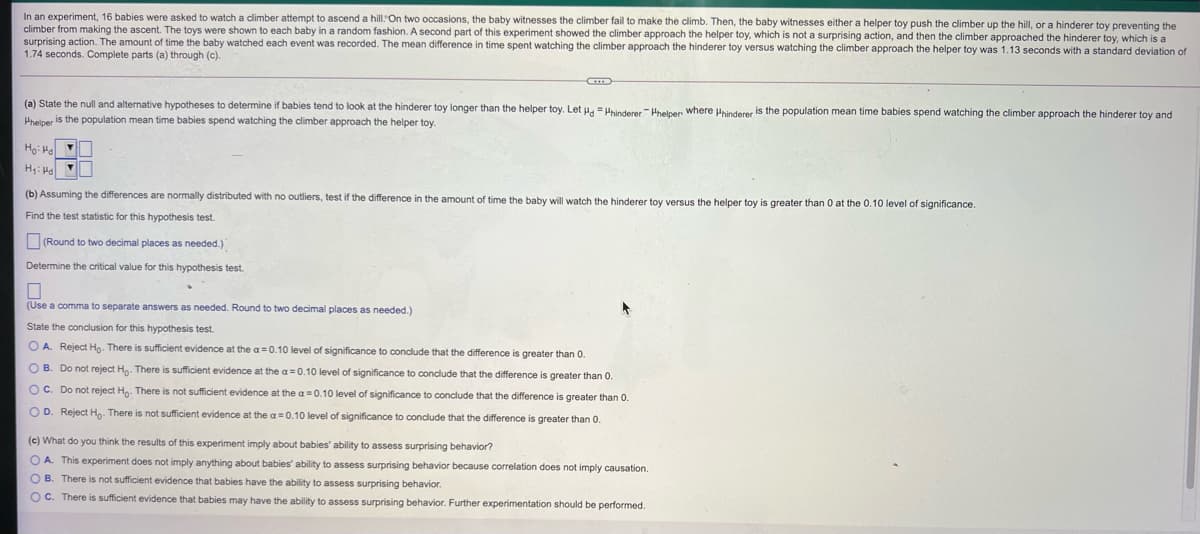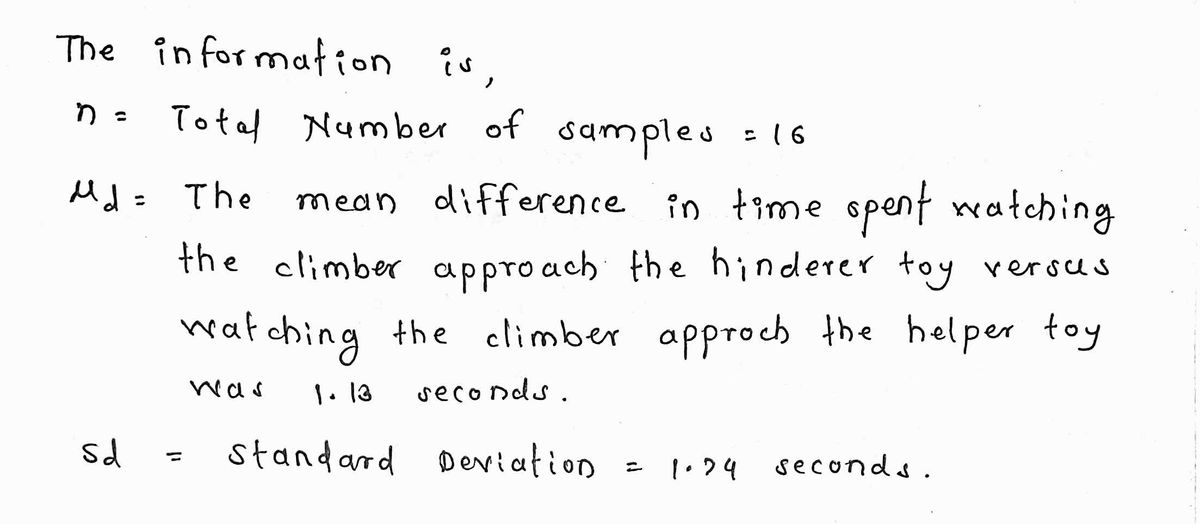In an experiment, 16 babies were asked to watch a climber attempt to ascend a hill' On two occasions, the baby witnesses the climber fail to make the climb. Then, the baby witnesses either a helper toy push the climber up the hill, or a hinderer toy preventing the climber from making the ascent. The toys were shown to each baby in a random fashion. A second part of this experiment showed t surprising action. The amount of time the baby watched each event was recorded. The mean difference in time spent watching the climber approach the hinderer toy versus watching the climber approach the helper toy was 1.13 seconds with a standard deviation of 1.74 seconds. Complete parts (a) through (c). climber approach the helper toy, which is not a surprising action, and then the climber approached the hinderer toy, which is a (a) State the null and alternative hypotheses to determine if babies tend to look at the hinderer toy longer than the helper toy. Let u. =Hninderer "Hhelper where Hhinderer is the population mean time babies spend watching the climber approach the hinderer toy and Hheiner is the population mean time babies spend watching the climber approach the helper toy. Ho: Ha H4: H (b) Assuming the differences are normally distributed with no outliers, test if the difference in the amount of time the baby will watch the hinderer toy versus the helper toy is greater than 0 at the 0.10 level of significance. Find the test statistic for this hypothesis test. (Round to two decimal places as needed.) Determine the critical value for this hypothesis test. (Use a comma to separate answers as needed. Round to two decimal places as needed.) State the conclusion for this hypothesis test. O A. Reject Ho. There is sufficient evidence at the a=0.10 level of significance to conclude that the difference is greater than 0. O B. Do not reject Ho. There is sufficient evidence at the a=0.10 level of significance to conclude that the difference is greater than 0. OC. Do not reject Ho. There is not sufficient evidence at the a =0.10 level of significance to conclude that the difference is greater than 0. O D. Reject Hp. There is not sufficient evidence at the a =0.10 level of significance to conclude that the difference is greater than 0. (c) What do you think the results of this experiment imply about babies' ability to assess surprising behavior? O A. This experiment does not imply anything about babies' ability to assess surprising behavior because correlation does not imply causation. O B. There is not sufficient evidence that babies have the ability to assess surprising behavior. OC. There is sufficient evidence that babies may have the ability to assess surprising behavior. Further experimentation should be performed.
In an experiment, 16 babies were asked to watch a climber attempt to ascend a hill' On two occasions, the baby witnesses the climber fail to make the climb. Then, the baby witnesses either a helper toy push the climber up the hill, or a hinderer toy preventing the climber from making the ascent. The toys were shown to each baby in a random fashion. A second part of this experiment showed t surprising action. The amount of time the baby watched each event was recorded. The mean difference in time spent watching the climber approach the hinderer toy versus watching the climber approach the helper toy was 1.13 seconds with a standard deviation of 1.74 seconds. Complete parts (a) through (c). climber approach the helper toy, which is not a surprising action, and then the climber approached the hinderer toy, which is a (a) State the null and alternative hypotheses to determine if babies tend to look at the hinderer toy longer than the helper toy. Let u. =Hninderer "Hhelper where Hhinderer is the population mean time babies spend watching the climber approach the hinderer toy and Hheiner is the population mean time babies spend watching the climber approach the helper toy. Ho: Ha H4: H (b) Assuming the differences are normally distributed with no outliers, test if the difference in the amount of time the baby will watch the hinderer toy versus the helper toy is greater than 0 at the 0.10 level of significance. Find the test statistic for this hypothesis test. (Round to two decimal places as needed.) Determine the critical value for this hypothesis test. (Use a comma to separate answers as needed. Round to two decimal places as needed.) State the conclusion for this hypothesis test. O A. Reject Ho. There is sufficient evidence at the a=0.10 level of significance to conclude that the difference is greater than 0. O B. Do not reject Ho. There is sufficient evidence at the a=0.10 level of significance to conclude that the difference is greater than 0. OC. Do not reject Ho. There is not sufficient evidence at the a =0.10 level of significance to conclude that the difference is greater than 0. O D. Reject Hp. There is not sufficient evidence at the a =0.10 level of significance to conclude that the difference is greater than 0. (c) What do you think the results of this experiment imply about babies' ability to assess surprising behavior? O A. This experiment does not imply anything about babies' ability to assess surprising behavior because correlation does not imply causation. O B. There is not sufficient evidence that babies have the ability to assess surprising behavior. OC. There is sufficient evidence that babies may have the ability to assess surprising behavior. Further experimentation should be performed.
Algebra & Trigonometry with Analytic Geometry
13th Edition
ISBN:9781133382119
Author:Swokowski
Publisher:Swokowski
Chapter10: Sequences, Series, And Probability
Section: Chapter Questions
Problem 27T
Related questions
Question
3) Need help with a,b,c

Transcribed Image Text:(c) What do you think the results of this experiment imply about babies' ability to assess surprising behavior?
O A. This experiment does not imply anything about babies' ability to assess surprising behavior because correlation does not imply causation.
O B. There is not sufficient evidence that babies have the ability to assess surprising behavior.
OC. There is sufficient evidence that babies may have the ability to assess surprising behavior. Further experimentation should be performed.
O D. There is sufficient evidence that babies have the ability to assess surprising behavior.

Transcribed Image Text:In an experiment, 16 babies were asked to watch a climber attempt to ascend a hill.' On two occasions, the baby witnesses the climber fail to make the climb. Then, the baby witnesses either a helper toy push the climber up the hill, or a hinderer toy preventing the
climber from making the ascent. The toys were shown to each baby in a random fashion. A second part of this experiment showed t
surprising action. The amount of time the baby watched each event was recorded. The mean difference in time spent watching the climber approach the hinderer toy versus watching the climber approach the helper toy was 1.13 seconds with a standard deviation of
1.74 seconds. Complete parts (a) through (c).
climber approach the helper toy, which is not a surprising action, and then the climber approached the hinderer toy, which is a
(a) State the null and alternative hypotheses to determine if babies tend to look at the hinderer toy longer than the helper toy. Let u. =Hhinderer "Hhelper where Phinderer is the population mean time babies spend watching the climber approach the hinderer toy and
Hhelper is the population mean time babies spend watching the climber approach the helper toy.
Ho: Ha
H: H
(b) Assuming the differences are normally distributed with no outliers, test if the difference in the amount of time the baby will watch the hinderer toy versus the helper toy is greater than 0 at the 0.10 level of significance.
Find the test statistic for this hypothesis test.
(Round to two decimal places as needed.)
Determine the critical value for this hypothesis test.
(Use a comma to separate answers as needed. Round to two decimal places as needed.)
State the conclusion for this hypothesis test.
O A. Reject Ho. There is sufficient evidence at the a=0.10 level of significance to conclude that the difference is greater than 0.
O B. Do not reject Ho. There is sufficient evidence at the a=0.10 level of significance to conclude that the difference is greater than 0.
OC. Do not reject Ho. There is not sufficient evidence at the a =0.10 level of significance to conclude that the difference is greater than 0.
O D. Reject Hp. There is not sufficient evidence at the a =0.10 level of significance to conclude that the difference is greater than 0.
(c) What do you think the results of this experiment imply about babies' ability to assess surprising behavior?
O A. This experiment does not imply anything about babies' ability to assess surprising behavior because correlation does not imply causation.
O B. There is not sufficient evidence that babies have the ability to assess surprising behavior.
OC. There is sufficient evidence that babies may have the ability to assess surprising behavior. Further experimentation should be performed.
Expert Solution
Step 1

Trending now
This is a popular solution!
Step by step
Solved in 2 steps with 2 images

Recommended textbooks for you

Algebra & Trigonometry with Analytic Geometry
Algebra
ISBN:
9781133382119
Author:
Swokowski
Publisher:
Cengage

Algebra & Trigonometry with Analytic Geometry
Algebra
ISBN:
9781133382119
Author:
Swokowski
Publisher:
Cengage